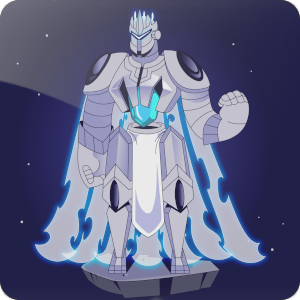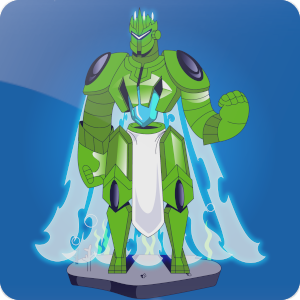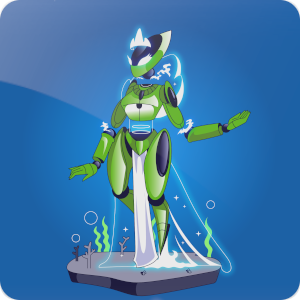Everything began about 3.5 billion years ago. A group of steel robots had settled on Megaclite, one of the moons of planet Jupiter. The steel robots, who called themselves Megaclite Troopers, were the last surviving beings in the entire Milky Way. They had been fighting for millions of years for supremacy against the Tritonians, a colony of the Canis Major galaxy, which settled on Triton, Neptunes largest moon. After the Megaclite Troopers won the battle and were the only survivors in the Milky Way, there was a long period of peace.
But from one day to the other, this idyll was over. Out of nowhere, a series of comet impacts hit the planet Jupiter and its moons. This was nothing new, but this scale was unprecedented. There were more casualties than in the battle against the Tritonians. The Megaclite Troopers were decimated and had to flee from Megaclite. King Yaku and Queen Inna were not able to flee. Both fell through one of the comet impacts as they tried to protect their own people. Without leadership, what had to happen happened. The Troopers lost sight of each other and fled in small groups to the far reaches of the galaxy to find a new home.
Each of the groups had to adapt to the difficult conditions of their new homes. For example, those who had retreated to colder regions had to find a way to cope with the ice, while others had to ensure they would not melt in extreme heat. In this way, each of the fleeing groups evolved into an entirely new species of Megaclite Troopers. Each tribe developed their own individual strengths. What unites them all to this day is the worship of King Yaku and Queen Inna.
"Together we defeated the Tritonians. Together we will be united for all eternity"
Our majesty - King Yaku

The Megaclite Troopers tribe on HD 189733 B had to get used to a surface temperature of 1000°C/1832°F, carbon monoxide, carbon dioxide, water steam as well as heavy storms. Distance from earth: 64 light years.
Locaton:view here



The Megaclite Troopers tribe on GJ 504 B has quickly adapted to a temperature of 237°C/460°F. Distance from earth: 57 light years. Since its discovery in 2013, Troopers of this tribe have been spotted a number of times using Subaru infrared telescope in Hawaii.
Locaton:view here



Well off is the Megaclite tribe which settled on Trappist-1 e, a terrestial rocky ocean planet in the habitable zone of star Trappist-1. It is the planet that shows the greatest similarity to Earth. It has an earth radius of 0.912, a temperature of -21°C/-17°F and a huge maritime world. Hubble Space telescope figured out that the troopers even adapted to life under water.
Locaton:view here



The Megaclite Troopers tribe on planet Neptune quickly had to adapt to freezing temperatures of -201°C/-130°F on the gas planet. The planet mainly consists of hydrogen, helium, methane. The reason for its blue color is that methane absorbs red light.
Locaton:view here



Enceladus, a moon of Saturn completely encased in ice, is home to one of the most interesting tribes in the Megaclite Troopers family. The cities of the Megaclite Troopers are hidden under a thick ice surface in the south. The Cassini spacecraft has had several visual contacts with patrolling troopers. Temperature: -198°C/-324°F
Locaton:view here
In depth: here



Another tribe in a habitable zone are the Troopers on the
exoplanet Kepler-22 B. About 635 light-years from Earth,
the Earth-like planet with an average temperature of 22°C/72°F,
offers a comfortable habitat.
Locaton:view here



At 1,799 light-years distant, the tribe on Kepler-452 b profit from Earth-like conditions in the habitable zone of star Kepler-452. The planet’s mountainous regions and temperatures of -8°C;/17°F provide optimal conditions for the troopers and the material they are made of. Due to the long distance, not a single Trooper has been sighted yet.
Locaton:view here



The Megaclite Troopers tribe on WASP-12 are truly one of the most special Megaclite populations.
They have chosen to the extreme temperatures on a star. WASP-12 is a star which is 1,393 light years away from Earth and has a mass and radius similar to the Sun.
Locaton:view here



The most heat-resistant tribe of the Megaclite family is located on KOI-55 b (Kepler-70b). The mountainous landscape has an Earth radius of 0,76 and an Earth mass of 0,44. It is the hottest exoplanet ever discovered and orbits the star Kepler-70.
Locaton:view here



The Megaclite Troopers families on planet Mars had to get used to a thin atmosphere with 96% carbon dioxide. Temperature variations on Mars range from -100 to +35°C (-166°F to +95°F). Because of its solid surface, the Troopers were able to build gigantic underground habitats.
Locaton:view here

